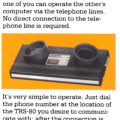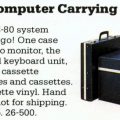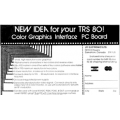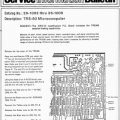The Omikron Mapper
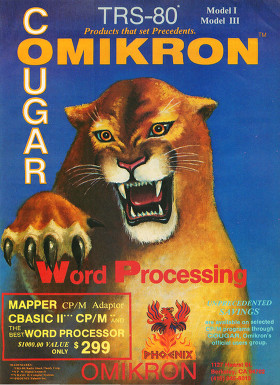
Omikron Mapper advertisement from the August 1981 issue of BYTE
Omikron Systems sold three versions of the Omikron Mapper from 1979 to 1984:
- The original Omikron Mapper I was for the Model I. In 1979, it cost $169.00 for a version that could use 5 1/4" floppy drives. A version that could use 8" drives cost $199.00.
- The Omikron Mapper II1 was a data separator that allowed a Model I with Expansion Interface to run CP/M using a combination of 5 1/4" and 8" drives. In 1980, it cost $99.00. Omikron originally bundled the Mapper I as part of the Mapper II, but later sold them separately. In addition to CP/M, NEWDOS/80 could also use the Mapper II to access 8" drives.
- The Omikron Mapper III was for the TRS-80 Model III. Unlike the Mapper I, it only supported 5 1/4" drives. It cost $199.00 in 1983.
Both the Mapper I and Mapper III were available in 48K and 64K versions.
Because CP/M was a disk operating system, the Omikron Mapper required a TRS-80 equipped with floppy drives. This meant an Expansion Interface was required on the Model I.
Omikron also sold 8" drives as a package with the Mapper I and II. Their price in 1979 for the first drive was $849.00. An additional 8" drive cost $645.00.
Installation
The Omikron Mapper I and III boards were fairly small, measuring around four by six inches. Most estimates for installation time ranged from 30 minutes to one hour, and no soldering was required in almost all cases.2
Installation was straightforward, with five main steps:
- Disassembling the TRS-80
- Removing the Z80 processor from the TRS-80 motherboard
- Plugging the Z80 into the Omikron Mapper board
- Plugging the Omikron Mapper board into the now empty Z80 socket
- Re-assembling the TRS-80
The Omikron Mapper I was slightly more difficult to install than the Omikron Mapper III, simply because the Model I case was a tighter fit.
Installing the Omikron Mapper II required one more step: adding a data separator chip inside the Expansion Interface. This could also be done with no soldering.
Usage
After installing the Omikron Mapper, the only visible changes were seen when starting the TRS-80. The Omikron Mapper would display a short message presenting two options:
- Pressing C would boot a CP/M disk
- Pressing T would boot a TRSDOS (or any other TRS-80 operating system) disk
In addition, pressing T and BREAK would start Level II cassette BASIC
CP/M
The Omikron Mapper supported both CP/M version 1.4 and CP/M version 2.2. The Omikron version of CP/M 2.2 came with MBASIC (the Microsoft BASIC interpreter), a 250-page CP/M manual, and an MBASIC manual. It emulated the SOROC IQ120 terminal and could read “17 disk formats, including Osborne, IBM PC, Cromemco, Xerox, DEC, and Superbrain.”
Omikron CP/M came with a number of helpful utilities, including:
- SETUP.COM – a customization utility for Omikron CP/M
- TRSCPM.COM – a utility to transfer files from TRSDOS formatted disks to CP/M disks
- OMCOPY.COM – a backup program for Omikron CP/M disks
- LFORMAT.COM – a format program for 8" disks
- MFORMAT.COM – a format program for 5 1/4" disks (also known as mini disks)
- LSYSGEN.COM – a utility to create a new 8" CP/M boot disk
- MSYSGEN.COM – a utility to create a new 5 1/4" CP/M boot disk
- MEMTEST.COM – a memory tester
- DSKTEST.COM – a program to “evaluate the condition of your drives”
- XDIR.COM – a wide directory display program
- SERIAL.COM – a CP/M driver for the serial port on the Radio Shack Expansion Interface
There were also Omikron specific versions of some CP/M utilities, such as STAT, PIP, and DDT.
Cougar
Omikron heavily promoted Cougar, which they billed as “Omikron’s official users' group.” In addition to being a users' group with a newsletter called the OMIGRAM, Cougar was a type of buyers club. It was described this way in a 1983 advertisement:
With Cougar, Omikron can arrange to purchase CP/M software products at high volume discounts. This allows us to offer our customers surprising discounts on top quality software products. Over a year’s time, many of our Cougar members save hundreds of additional dollars on software purchases.
Those savings could be substantial. According to a 1982 article in 80 Microcomputing, WordStar had a list price of $495.00 but it could be purchased through Cougar for $149.00. Similarly, CBASIC had a list price of $50 but cost $39 through Cougar.
Competition
At around $199, the Omikron Mapper was cheaper than its primary competitors, the Parasitic Engineering (later Memory Merchant) Shuffleboard III (at $299) and the Holmes VID-80 (at $399).
Unlike the Holmes VID-80, which increased the text display size to 80 by 24, the Omikron Mapper maintained the 64 by 16 display size of the TRS-80. This caused problems with some CP/M programs which expected the more common 80 by 24 display size. Omikron advertised an add-on for the Mapper to expand the TRS-80 screen to 80 by 24. The advertisements said it would be “available 2nd quarter 1983” but I’ve never seen any indication that it was produced.
The introduction of the TRS-80 Model 4 in 1983 must have hurt sales of the Omikron Mapper. The Model 4 offered complete TRSDOS and CP/M support, along with an improved keyboard and an 80 by 24 screen. Omikron filed for Chapter 11 bankruptcy on February 11, 1984.
The Mappa-1
In February 2016, Ian Mavric released the Mappa-1, a powerful new CP/M add-on for the Model I that is software compatible with the Omikron Mapper. You can find out more on his Mappa-1 page.
-
Despite the numbering, the Omikron Mapper II was for the Model I, not the Model II. The Omikron Mapper wouldn’t have made any sense as a Model II product because the Model II could already run CP/M natively. ↩︎
-
Some early Model I systems required a minor modification to the power supply in order to work with the Omikron Mapper. This modification did require soldering. ↩︎
